2023 TOYOTA PRIUS PLUG-IN HYBRID warning
[x] Cancel search: warningPage 141 of 818
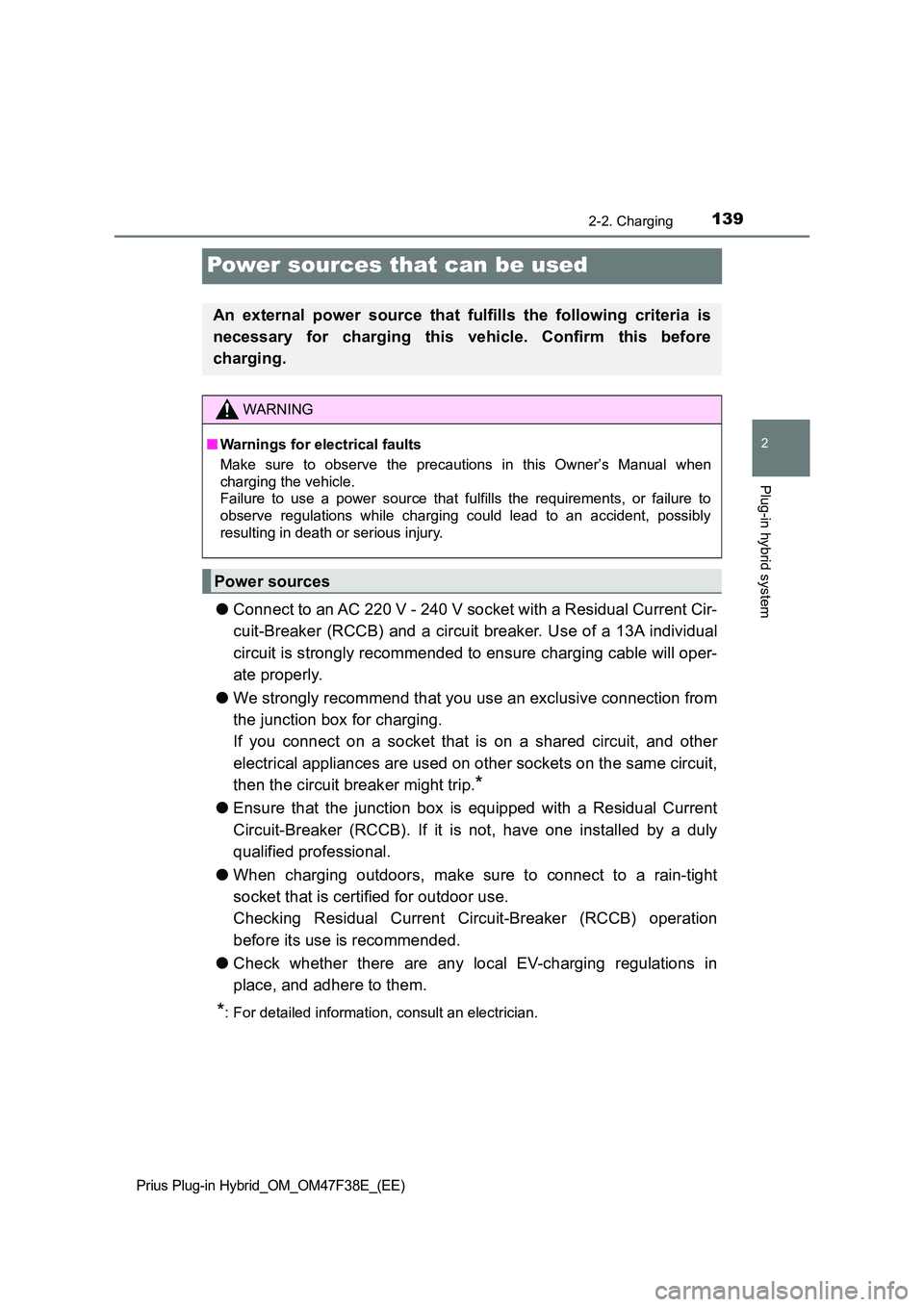
139
2
2-2. Charging
Plug-in hybrid system
Prius Plug-in Hybrid_OM_OM47F38E_(EE)
Power sources that can be used
●Connect to an AC 220 V - 240 V socket with a Residual Current Cir-
cuit-Breaker (RCCB) and a circuit breaker. Use of a 13A individual
circuit is strongly recommended to ensure charging cable will oper-
ate properly.
● We strongly recommend that you use an exclusive connection from
the junction box for charging.
If you connect on a socket that is on a shared circuit, and other
electrical appliances are used on other sockets on the same circuit,
then the circuit breaker might trip.*
● Ensure that the junction box is equipped with a Residual Current
Circuit-Breaker (RCCB). If it is not, have one installed by a duly
qualified professional.
● When charging outdoors, make sure to connect to a rain-tight
socket that is certified for outdoor use.
Checking Residual Current Circuit-Breaker (RCCB) operation
before its use is recommended.
● Check whether there are any local EV-charging regulations in
place, and adhere to them.
*: For detailed information, consult an electrician.
An external power source that fulfills the following criteria is
necessary for charging this vehicle. Confirm this before
charging.
WARNING
■ Warnings for electrical faults
Make sure to observe the precautions in this Owner’s Manual when
charging the vehicle.
Failure to use a power source that fulfills the requirements, or failure to
observe regulations while charging could lead to an accident, possibly
resulting in death or serious injury.
Power sources
Page 143 of 818
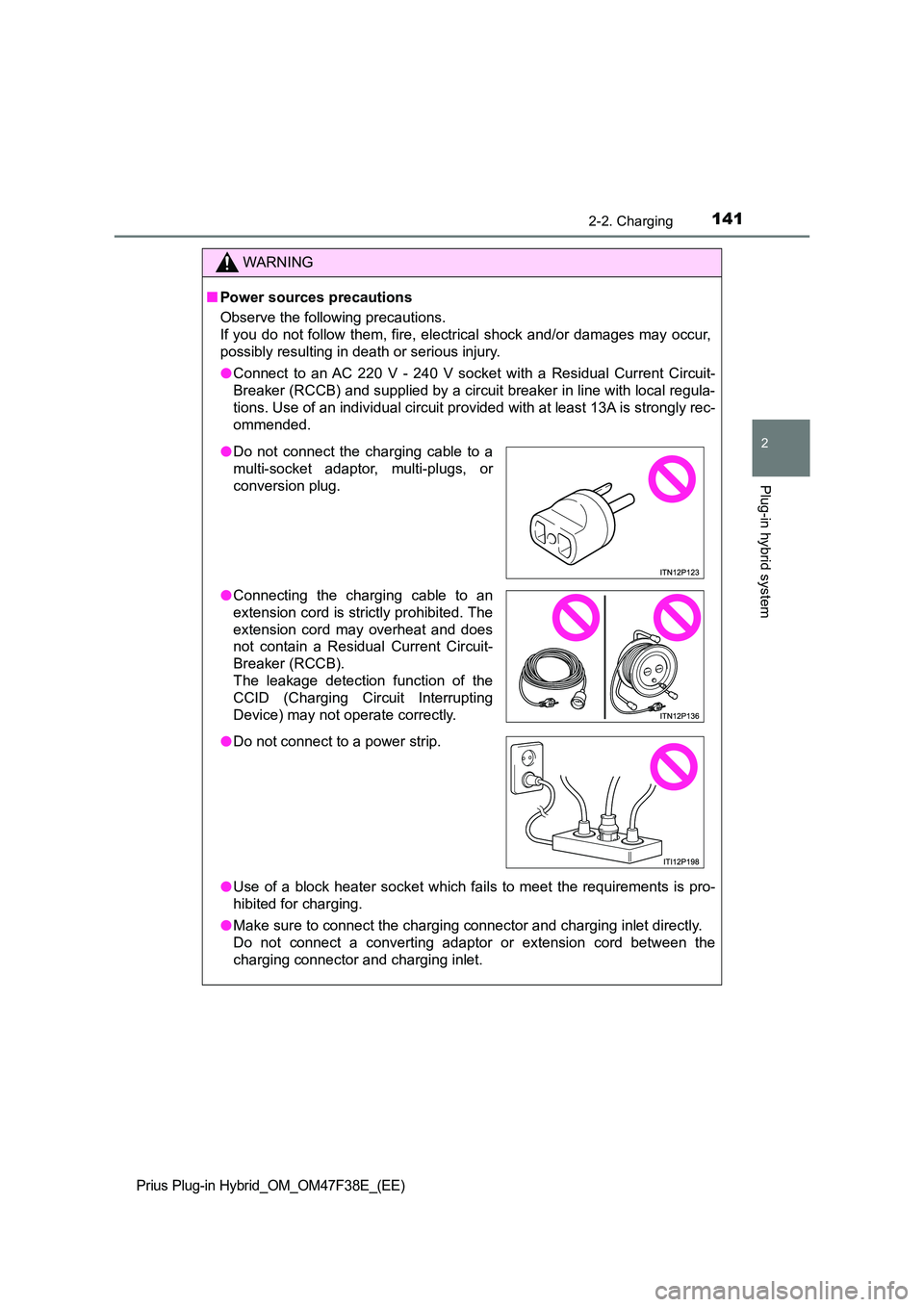
1412-2. Charging
2
Plug-in hybrid system
Prius Plug-in Hybrid_OM_OM47F38E_(EE)
WARNING
■Power sources precautions
Observe the following precautions.
If you do not follow them, fire, electrical shock and/or damages may occur,
possibly resulting in death or serious injury.
● Connect to an AC 220 V - 240 V socket with a Residual Current Circuit-
Breaker (RCCB) and supplied by a circuit breaker in line with local regula-
tions. Use of an individual circuit provi ded with at least 13A is strongly rec-
ommended.
● Use of a block heater socket which fails to meet the requirements is pro-
hibited for charging.
● Make sure to connect the charging connector and charging inlet directly.
Do not connect a converting adaptor or extension cord between the
charging connector and charging inlet.
● Do not connect the charging cable to a
multi-socket adaptor, multi-plugs, or
conversion plug.
● Connecting the charging cable to an
extension cord is strictly prohibited. The
extension cord may overheat and does
not contain a Residual Current Circuit-
Breaker (RCCB).
The leakage detection function of the
CCID (Charging Circuit Interrupting
Device) may not operate correctly.
● Do not connect to a power strip.
Page 155 of 818
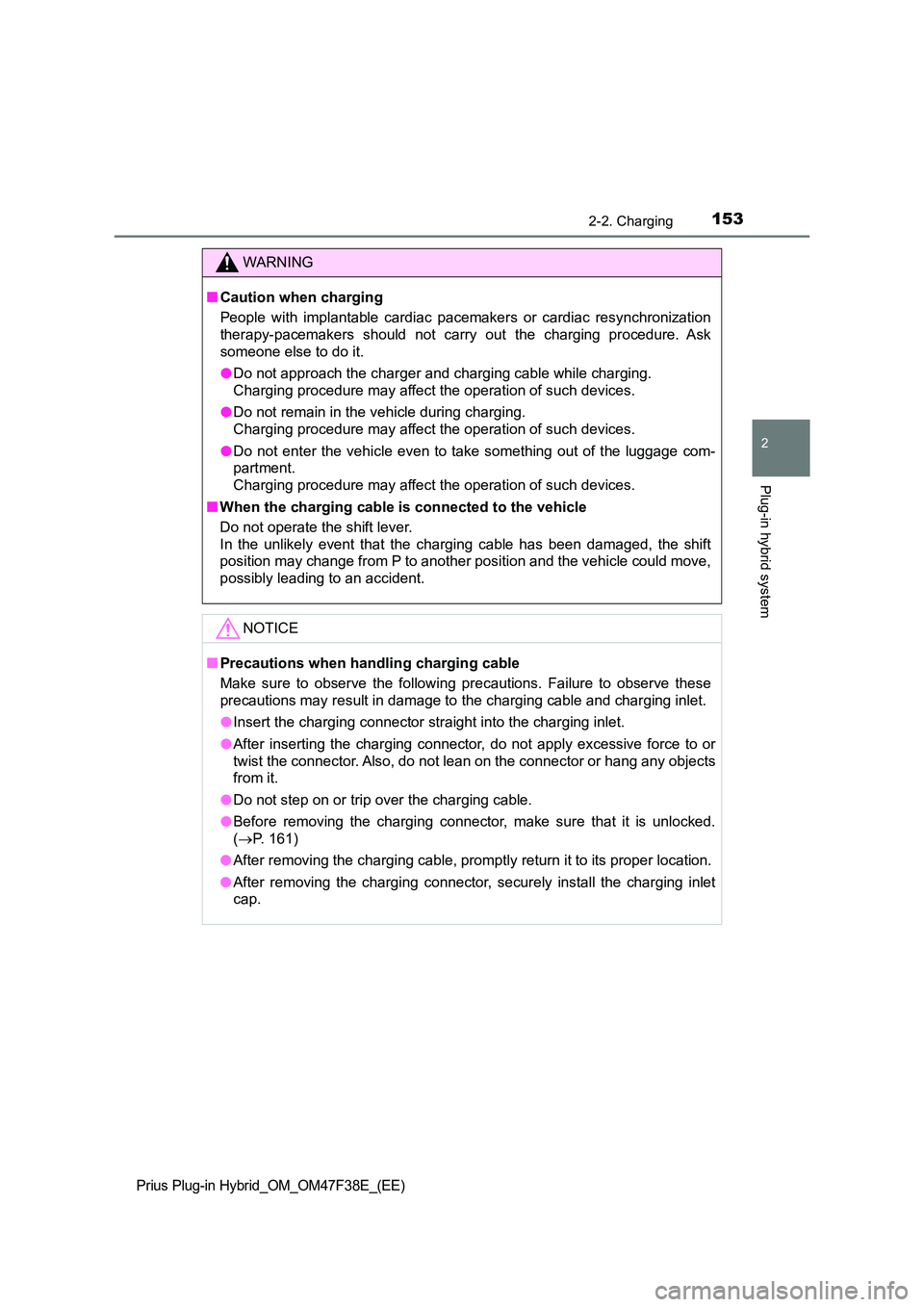
1532-2. Charging
2
Plug-in hybrid system
Prius Plug-in Hybrid_OM_OM47F38E_(EE)
WARNING
■Caution when charging
People with implantable cardiac pacemakers or cardiac resynchronization
therapy-pacemakers should not carry out the charging procedure. Ask
someone else to do it.
● Do not approach the charger and charging cable while charging.
Charging procedure may affect the operation of such devices.
● Do not remain in the vehicle during charging.
Charging procedure may affect the operation of such devices.
● Do not enter the vehicle even to take something out of the luggage com-
partment.
Charging procedure may affect the operation of such devices.
■ When the charging cable is connected to the vehicle
Do not operate the shift lever.
In the unlikely event that the charging cable has been damaged, the shift
position may change from P to another position and the vehicle could move,
possibly leading to an accident.
NOTICE
■ Precautions when handling charging cable
Make sure to observe the following precautions. Failure to observe these
precautions may result in damage to the charging cable and charging inlet.
● Insert the charging connector straight into the charging inlet.
● After inserting the charging connector, do not apply excessive force to or
twist the connector. Also, do not lean on the connector or hang any objects
from it.
● Do not step on or trip over the charging cable.
● Before removing the charging connector, make sure that it is unlocked.
( P. 161)
● After removing the charging cable, promptly return it to its proper location.
● After removing the charging connector, securely install the charging inlet
cap.
Page 160 of 818

1582-2. Charging
Prius Plug-in Hybrid_OM_OM47F38E_(EE)
If the charging indicator flashes
after inserting the charging con-
nector:
The charge schedule is regis-
tered (P. 166). Carry an elec-
tronic key and press the
charging connector lock switch
to unlock the charging connec-
tor.
After temporarily removing the charging connector, reinsert it within
approximately 5 seconds. (P. 158)
If the error warning indicator on the CCID (Charging Circuit Interrupting
Device) flashes during charging, check P. 120 and follow the correction
procedure.
The charging indicator will turn off when charging is completed.
■During charging
●The surface of the CCID (Charging Circuit Interrupting Device) may become
hot, but this does not indicate a malfunction. (When using Mode 2 charging
cable.)
●Depending on radio wave conditions, interference may be heard on the
radio.
●The current charging condition and the estimated time until charging will
complete can be checked on the multi-information display. (P. 149)
●During charging, the hybrid battery (traction battery) status indicator illumi-
nates and flashes, and changes according to the charging amount.
(P. 113)
■If the charging indicator flashes after connecting the charging cable
The charge schedule (P. 166) is registered and charging cannot be per-
formed. To cancel charging using the charging schedule and start charging,
perform any of the following procedures.
●Turn “Charge Now” on (P. 174)
●While the charging indicator is flashing, remove and reconnect the charging
connector within 5 seconds
■When the charging connector cannot be inserted into the charging inlet
P. 135
Page 164 of 818

1622-2. Charging
Prius Plug-in Hybrid_OM_OM47F38E_(EE)
WARNING
■When charging
Observe the following precautions.
Failure to do so may cause an unexpected accident, resulting in death or
serious injury.
● Connect to a power source suitable for charging. (P. 139)
● Before charging, check that the charging inlet does not have deformations,
damage, corrosion, dust or other foreign materials such as snow or ice
adhering to it. If anything is adhering to the inlet, be sure to completely
remove the material before connecting the charging connector.
● Mode 3 charging cable: Before inserting the charging plug into the char-
ger, make sure there is no dirt or dust on the terminal areas. If there is dirt
or dust on these areas, remove it completely before inserting the charging
plug.
● Do not let the terminals of the charging inlet get wet.
● Make sure that the charging cable, plug and socket are free of foreign mat-
ter and not deformed or damaged.
● Only use sockets where the plug can be securely inserted.
● Do not charge if the charging cable is coiled or bundled.
● Wrapping the charging cable while in-use is not recommended because
cable may overheat. Failure to rewrap charging cable when not in-use
could result in strangulation or tripping hazard.
● Do not touch the terminals of the charging connector and charging inlet
with a sharp metal objects (needles etc.) or hands, or short them with for-
eign objects.
● When charging outdoors, make sure to connect to a rain-tight socket for
outdoor use.
Ensure the rain-tight cover closes completely. If the rain-tight cover cannot
be closed, install a rain-tight cover that will close.
● If any heat, smoke, odors, noise or other abnormalities are noticed during
charging, stop charging immediately.
● Do not insert the plug if the socket is submerged in water or snow.
● When charging during rain or snow, do not pull out or insert the plug with
wet hands. Also, do not get the electrical socket and plug wet.
● Do not charge the vehicle during a lightning storm.
● Do not let the wheels on the charging cable, plug, charging connector and
CCID (Charging Circuit Interrupting Device).
● Firmly insert the plug into the socket.
● Do not use an extension cord and converting adaptor.
Page 165 of 818
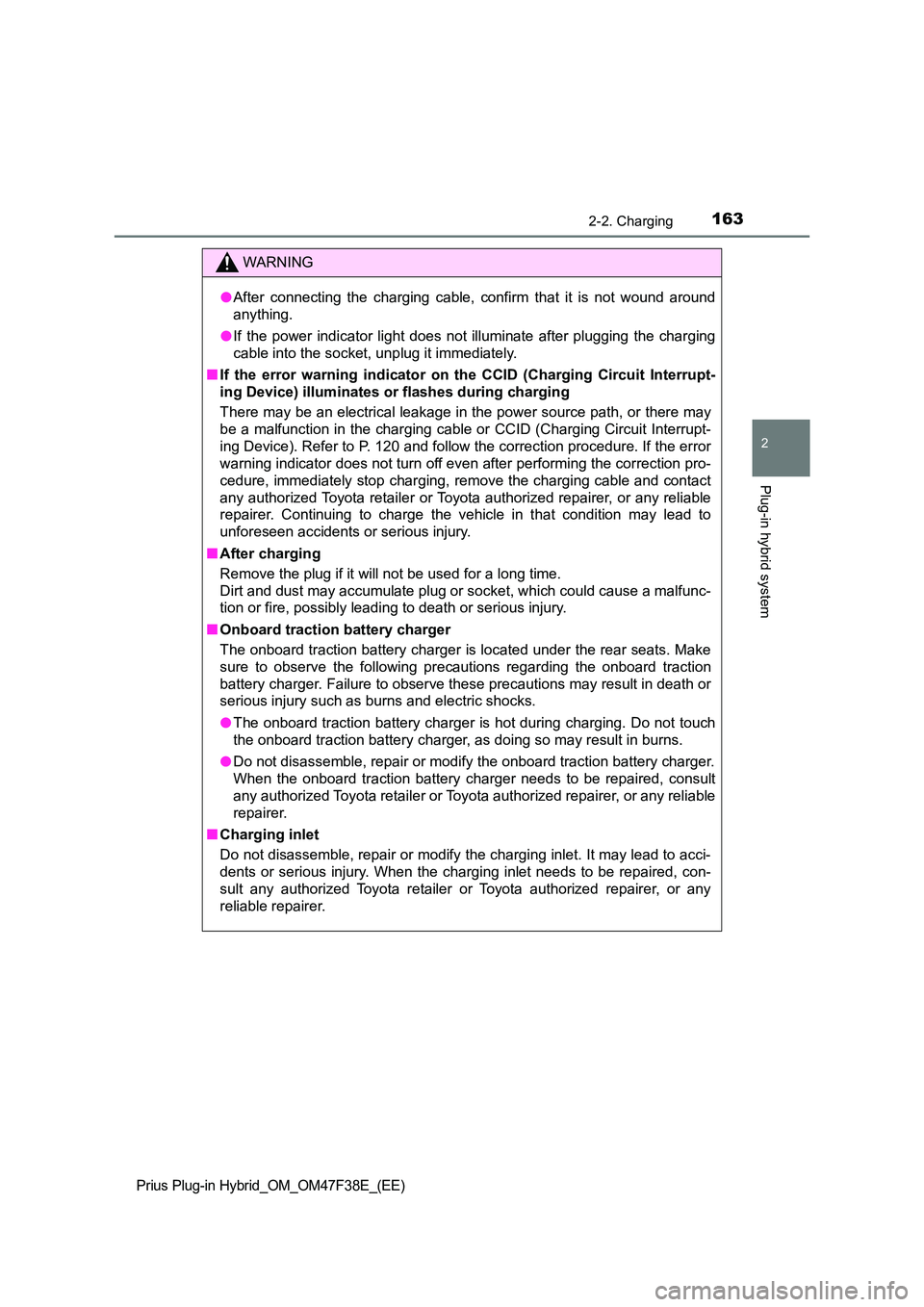
1632-2. Charging
2
Plug-in hybrid system
Prius Plug-in Hybrid_OM_OM47F38E_(EE)
WARNING
●After connecting the charging cable, confirm that it is not wound around
anything.
● If the power indicator light does not illuminate after plugging the charging
cable into the socket, unplug it immediately.
■ If the error warning indicator on the CCID (Charging Circuit Interrupt-
ing Device) illuminates or flashes during charging
There may be an electrical leakage in t he power source path, or there may
be a malfunction in the charging cable or CCID (Charging Circuit Interrupt-
ing Device). Refer to P. 120 and follow the correction procedure. If the error
warning indicator does not turn off even after performing the correction pro-
cedure, immediately stop charging, remove the charging cable and contact
any authorized Toyota retailer or Toyota authorized repairer, or any reliable
repairer. Continuing to charge the vehicle in that condition may lead to
unforeseen accidents or serious injury.
■ After charging
Remove the plug if it will not be used for a long time.
Dirt and dust may accumulate plug or socket, which could cause a malfunc-
tion or fire, possibly leading to death or serious injury.
■ Onboard traction battery charger
The onboard traction battery charger is located under the rear seats. Make
sure to observe the following precautions regarding the onboard traction
battery charger. Failure to observe these precautions may result in death or
serious injury such as burns and electric shocks.
● The onboard traction battery charger is hot during charging. Do not touch
the onboard traction battery charger, as doing so may result in burns.
● Do not disassemble, repair or modify the onboard traction battery charger.
When the onboard traction battery charger needs to be repaired, consult
any authorized Toyota retailer or Toyota authorized repairer, or any reliable
repairer.
■ Charging inlet
Do not disassemble, repair or modify the charging inlet. It may lead to acci-
dents or serious injury. When the charging inlet needs to be repaired, con-
sult any authorized Toyota retailer or Toyota authorized repairer, or any
reliable repairer.
Page 167 of 818
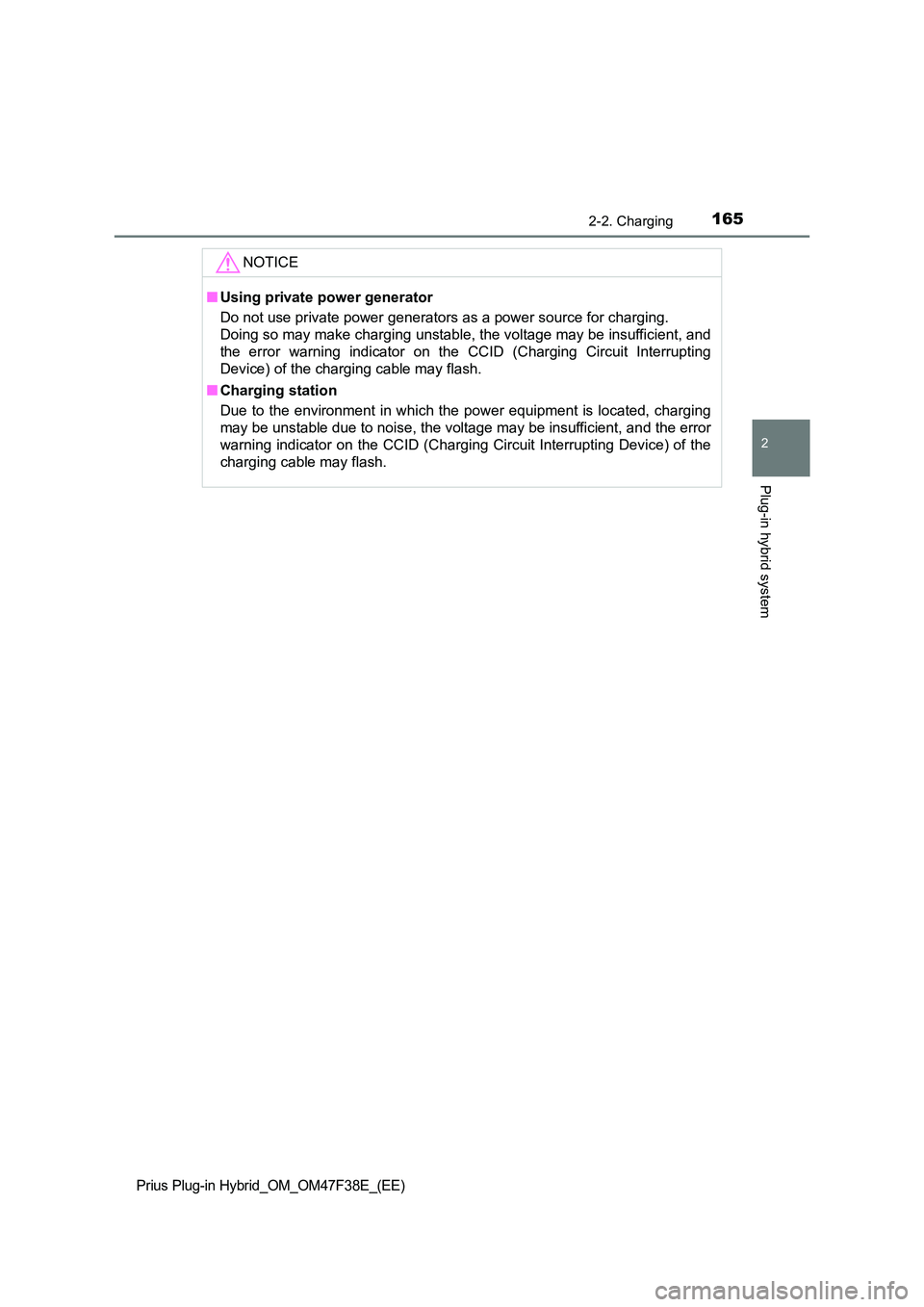
1652-2. Charging
2
Plug-in hybrid system
Prius Plug-in Hybrid_OM_OM47F38E_(EE)
NOTICE
■Using private power generator
Do not use private power generators as a power source for charging.
Doing so may make charging unstable, the voltage may be insufficient, and
the error warning indicator on the CCID (Charging Circuit Interrupting
Device) of the charging cable may flash.
■ Charging station
Due to the environment in which the power equipment is located, charging
may be unstable due to noise, the voltage may be insufficient, and the error
warning indicator on the CCID (Charging Circuit Interrupting Device) of the
charging cable may flash.
Page 179 of 818

1772-2. Charging
2
Plug-in hybrid system
Prius Plug-in Hybrid_OM_OM47F38E_(EE)
■When “Next Charging Event” is changed while charging
● When the charging mode is “Departure”, the current charging is interrupted
or continued depending on the remaining time until the charging is com-
pleted.
● When the charging mode is “Start”, the current charging is interrupted, the
next charging will start at the set time.
■ When the power switch is turned off
It is possible to check the next charge
schedule (“Next Charging Event”) by oper-
ating or of the meter control
switches while the power switch is turned
off and the “Ending” screen*1 ( P. 198) is
displayed.*2
*1: The “Ending” screen may not be dis-
played during charging.
*2: When the power switch is turned off, the “Next Charging Event” confir-
mation screen may be displayed.
WARNING
■ Cautions while performing the setting operation
When performing the setting operation while the hybrid system is operated,
ensure that the vehicle is parked in a place with adequate ventilation. In a
closed area such as a garage, exhaust gases including harmful carbon
monoxide (CO) may collect and enter the vehicle. This may lead to death or
a serious health hazard.
NOTICE
■ While performing the setting operation
When performing the setting operation while the hybrid system is stopped,
be careful that the 12-volt battery will not be discharged.